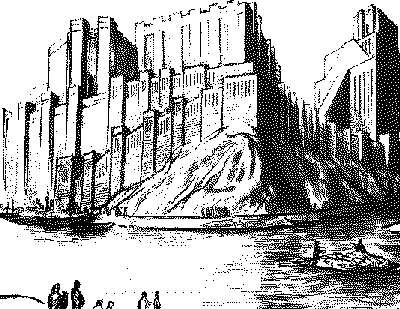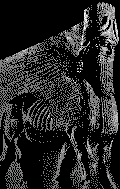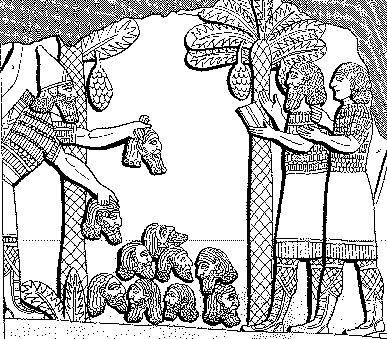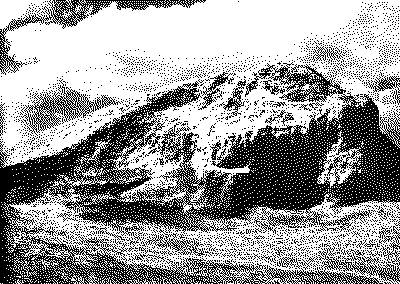2 Kings 15:19 - "And Pul the king of Assyria came against Israel: and Menahem gave Pul a thousand talents of silver, that his hand might be with him to confirm the kingdom in his hand."
The Old Testament - A Brief Overview
The Assyrians

Assyria was a kingdom located between the Tigris and Euphrates Rivers that dominated the ancient world from the ninth century to the seventh century B. C. Its capital was Nineveh. In stature the Assyrians were of average modern European height, and were powerfully built. Their complexion was dark, the nose prominent, the hair, eyebrows, and beard thick and bushy. They rarely intermarried with neighboring peoples.
The early inhabitants of Assyria were ancient tribesmen (Gen. 10:22) who probably migrated from Babylonia. They grew powerful enough around 1300 B. C. to conquer Babylonia. For the next 700 years they were the leading power in the ancient world, with their leading rival nation, Babylon, constantly challenging them for this position.
The ancient city of Ashur (west bank of the Tigris)
 Assyrian
policy was to deport conquered peoples to other lands within the empire, to
destroy their sense of nationalism, and break any pride or hope of rebellion and
replace them with strangers from far away. Assyrians were great warriors. Most
nations at that time period were looters, building their state by robbing other
nations. Assyria was the most ferocious of them all. Their very name became a
byword for cruelty and atrocity. They skinned their prisoners alive, and cut off
various body parts to inspire terror in their enemies. There is records of
Assyrian officials pulling out tongues and displaying mounds of human skulls all
to bring about stark horror and wealthy tribute from surrounding nations.
Nowhere are the pages of history more bloody than in the records of their wars.
Assyrian
policy was to deport conquered peoples to other lands within the empire, to
destroy their sense of nationalism, and break any pride or hope of rebellion and
replace them with strangers from far away. Assyrians were great warriors. Most
nations at that time period were looters, building their state by robbing other
nations. Assyria was the most ferocious of them all. Their very name became a
byword for cruelty and atrocity. They skinned their prisoners alive, and cut off
various body parts to inspire terror in their enemies. There is records of
Assyrian officials pulling out tongues and displaying mounds of human skulls all
to bring about stark horror and wealthy tribute from surrounding nations.
Nowhere are the pages of history more bloody than in the records of their wars.

Assyrian scribes recording the number slain

Assyrian king putting out the eyes of
an enemy king and leading the officials
into captivity with hooks in their lips

The ruins of Nineveh
On the east bank of the Tigris river lay massive mounds of ruins where there stood the splendid capital city of the Assyrians with its great palaces and buildings. There is record of Alexander the Great, when he was near Nineveh, not recognizing that it once was the center of the great Assyrian empire.
The religion of the Assyrians, much like that of the Babylonians, emphasized worship of nature. They believed every object of nature was possessed by a spirit. The chief god was Asshur. All other primary gods whom they worshiped were related to the objects of nature. These included Anu, god of the heavens; Bel, god of the region inhabited by man, beasts, and birds; Ea, god of the waters; Sin, the moon-god; Shamash, the sun-god; and Ramman, god of the storms. These gods were followed by five gods of the planets. In addition to these primary gods, lesser gods also were worshiped. In some cases, various cities had their own patron gods. The pagan worship of the Assyrians was vehemently condemned by several prophets of the Old Testament (Is. 10:5; Ezek. 16:28; Hos. 8.9)Here is a list of most of the later kings of Assyria (885-607 B.C.):
Assur-nasipal II (885-860 B.C.)Shalmaneser II (860-825 B.C.)
Shansi-adad (825-808 B.C.)Adad-nirari (808-783 B.C.)
Shalmaneser III (783-771 B.C.)Assur-dayan (771-753 B.C.)
Assur-lush (753-747 B.C.)Tiglath-pileser III (Pul) (747-727 B.C.)
Shalmaneser IV (727-722 B.C.)Sargon II (722-705 B.C.)
Sennacherib (705-681 B.C.)Esar-haddon (681-668 B.C.)
Assur-banipal (668-626 B.C.)Assur-etil-ilani (626-607 B.C.)
Assyrian annals mention contacts with some nine Hebrew kings: Omri, Ahab, Jehu, Menahem, Pekah, Uzziah, Ahaz, Hezekiah, and Manasseh.Because of the cruelty and paganism of the Assyrians, the Hebrew people harbored deep-seated hostility against this nation. This attitude is revealed clearly in the Book of Jonah. When God instructed Jonah to preach to Nineveh, the capital of Assyria, Jonah refused and went in the opposite direction. After he finally went to Nineveh, the prophet was disappointed with God because He spared the city. 150 years later The prophet Nahum spoke against Assyria indicating that they were ripe for the slaughter.
Read The Bible
- 1599 Geneva Bible (GNV)
- 21st Century King James Version (KJ21)
- American Standard Version (ASV)
- Amplified Bible (AMP)
- Amplified Bible, Classic Edition (AMPC)
- Authorized (King James) Version (AKJV)
- BRG Bible (BRG)
- Christian Standard Bible (CSB)
- Common English Bible (CEB)
- Complete Jewish Bible (CJB)
- Contemporary English Version (CEV)
- Darby Translation (DARBY)
- Disciples’ Literal New Testament (DLNT)
- Douay-Rheims 1899 American Edition (DRA)
- Easy-to-Read Version (ERV)
- English Standard Version (ESV)
- English Standard Version Anglicised (ESVUK)
- Evangelical Heritage Version (EHV)
- Expanded Bible (EXB)
- GOD’S WORD Translation (GW)
- Good News Translation (GNT)
- Holman Christian Standard Bible (HCSB)
- International Children’s Bible (ICB)
- International Standard Version (ISV)
- J.B. Phillips New Testament (PHILLIPS)
- Jubilee Bible 2000 (JUB)
- King James Version (KJV)
- Lexham English Bible (LEB)
- Living Bible (TLB)
- Modern English Version (MEV)
- Mounce Reverse Interlinear New Testament (MOUNCE)
- Names of God Bible (NOG)
- New American Bible (Revised Edition) (NABRE)
- New American Standard Bible (NASB)
- New American Standard Bible 1995 (NASB1995)
- New Catholic Bible (NCB)
- New Century Version (NCV)
- New English Translation (NET)
- New International Reader's Version (NIRV)
- New International Version - UK (NIVUK)
- New International Version (NIV)
- New King James Version (NKJV)
- New Life Version (NLV)
- New Living Translation (NLT)
- New Matthew Bible (NMB)
- New Revised Standard Version (NRSV)
- New Revised Standard Version Catholic Edition (NRSVCE)
- New Revised Standard Version, Anglicised (NRSVA)
- New Revised Standard Version, Anglicised Catholic Edition (NRSVACE)
- New Testament for Everyone (NTE)
- Orthodox Jewish Bible (OJB)
- Revised Geneva Translation (RGT)
- Revised Standard Version (RSV)
- Revised Standard Version Catholic Edition (RSVCE)
- The Message (MSG)
- The Voice (VOICE)
- Tree of Life Version (TLV)
- World English Bible (WEB)
- Worldwide English (New Testament) (WE)
- Wycliffe Bible (WYC)
- Young's Literal Translation (YLT)
Table of Contents
The Story of the Bible
- The Old Testament
- Quick Summary
- About
- Divisions
- Timeline
- Charts
- Maps
- Creation
- Adam and Eve
- The Flood
- The Tower of Babel
- Abraham the First Hebrew
Isaac, Son of Promise
- Jacob and the 12 Tribes
- Joseph and Egypt
- Moses and the Exodus
- The Giving of the Law
- The Tabernacle
- The Wilderness Wanderings
- Joshua and the Promised Land
- The Judges
- Samuel the Prophet
- Saul, Israel's First King
- King David
- King Solomon
- The Divided Kingdom
- The Northern Kingdom of Israel
- The Southern Kingdom of Judah
- The Assyrian Captivity
- The Babylonian Captivity
- The Return From Babylon
- The Prophets
- The Messiah
- Conclusion
- Bibliography and Credits
Summary of the Old Testament Books
- Genesis
- Exodus
- Leviticus
- Numbers
- Deuteronomy
- Joshua
- Judges
- Ruth
- Samuel
- Kings
- Chronicles
- Ezra
- Nehemiah
- Esther
- Job
- Psalms
- Proverbs
- Ecclesiastes
- Song of Solomon
- Isaiah
- Jeremiah
- Lamentations
- Ezekiel
- Daniel
- Hosea
- Joel
- Amos
- Obadiah
- Jonah
- Micah
- Nahum
- Habakkuk
- Zephaniah
- Haggai
- Zechariah
- Malachi
Read the Old Testament Stories
Bibliography Resources on the Old Testament
- A Survey of Old Testament Introduction, Revised and Expanded by Archer, 508 Pages, Pub. 2007
- The Old Testament: A Historical, Theological, and Critical Introduction
- Introducing the Old Testament: A Historical, Literary, and Theological Survey
- A Survey of the Old Testament
- An Introduction to the Old Testament: Second Edition
- Old Testament Theology
- A Biblical-Theological Introduction to the Old Testament: The Gospel Promised
Old Testament Charts to Help with the Study of the Bible
- Old Testament Books
- Old Testament Books in English Order
- Old Testament Books in Hebrew Order
- Old Testament Books - Hebrew Meanings
- Divisions of the Old Testament
- Timeline of the Pentateuch
- Adam and Eve, a Type of Christ and the Church
- The Table of Nations in Genesis 10
- Lifespans in Genesis
- The Lineage of Christ in Genesis
- The Family Tree of Esau
- The 12 Tribes of Israel
- Joseph, A Type of Christ
- The Encampment of Israel
- The Hebrew Calendar of Months
- The 7 Feasts and God's Calendar
- The Feasts and Festivals of Israel
- Scriptures and Procedures of the Feasts
- Chapters, Verses, and Words in the Old Testament
- Miracles in the Old Testament
- Parables in the Old Testament
- Gentile Nations in the Old Testament
- The Servant of the LORD, Israel and the Messiah
- The Distinction Between Kings and Chronicles
- The Judges who Delivered Israel
- The Royal House of David
- The Kings of Israel
- The Kings of Judah
- Chronology of Israel and Judah's Kings and Prophets
- Chronology of the Prophets
- Messages of the Prophets
- Kings of the Assyrian Empire
- Kings of the Babylonian Empire
- Kings of the Persian Empire
- Cuneiform Inscriptions with Names of Foreign Kings
Main Menu
- Ancient Assyrian Social Structure
- Ancient Babylonia
- Ancient Canaan During the Time of Joshua
- Ancient History Timeline
- Ancient Oil Lamps
- Antonia Fortress
- Archaeology of Ancient Assyria
- Assyria and Bible Prophecy
- Augustus Caesar
- Background Bible Study
- Bible
- Biblical Geography
- Fallen Empires - Archaeological Discoveries and the Bible
- First Century Jerusalem
- Glossary of Latin Words
- Herod Agrippa I
- Herod Antipas
- Herod the Great
- Herod's Temple
- High Priest's in New Testament Times
- Jewish Literature in New Testament Times
- Library collection
- Map of David's Kingdom
- Map of the Divided Kingdom - Israel and Judah
- Map of the Ministry of Jesus
- Matthew Henry Bible Commentary
- Messianic Prophecy
- Nero Caesar Emperor
- Online Bible Maps
- Paul's First Missionary Journey
- Paul's Second Missionary Journey
- Paul's Third Missionary Journey
- Pontius Pilate
- Questions About the Ancient World
- Tabernacle of Ancient Israel
- Tax Collectors in New Testament Times
- The Babylonian Captivity
- The Black Obelisk of Shalmaneser
- The Books of the New Testament
- The Court of the Gentiles
- The Court of the Women in the Temple
- The Destruction of Israel
- The Fall of Judah with Map
- The History Of Rome
- The Incredible Bible
- The Jewish Calendar in Ancient Hebrew History
- The Life of Jesus in Chronological Order
- The Life of Jesus in Harmony
- The Names of God
- The New Testament
- The Old Testament
- The Passion of the Christ
- The Pharisees
- The Sacred Year of Israel in New Testament Times
- The Samaritans
- The Scribes
Ancient Questions
- Why Do the Huldah Gates Appear Different in Ancient Replicas and Modern Photos?
- What Is the Origin of the Japanese and Chinese Peoples? A Biblical Perspective
- How did the ancient Greeks and Romans practice medicine and treat illnesses?
- What were the major contributions of ancient Babylon to mathematics and astronomy?
- How did the ancient Persians create and administer their vast empire?
- What were the cultural and artistic achievements of ancient India, particularly during the Gupta Empire?
- How did ancient civilizations like the Incas and Aztecs build their remarkable cities and structures?
- What were the major trade routes and trading practices of the ancient world?
- What was the role of slavery in ancient societies like Rome and Greece?
- How did the ancient Mayans develop their sophisticated calendar system?
Bible Study Questions
- Why Do Christians Celebrate Christmas?
- How Many Chapters Are There in the Bible?
- The Five Key Visions in the New Testament
- The 400-Year Prophecy: Unpacking Genesis 15 and the Journey of a People
- The Authorized (King James) Version (AKJV): Historical Significance, Translation Methodology, and Lasting Impact
- Exploring the English Standard Version (ESV): Its Aspects, Comparisons, Impact on Biblical Studies, and Church Use
- A Detailed Historical Analysis of Language Updates in the KJ21: Comparison with Other Versions
- A Detailed Historical Analysis of the American Standard Version (ASV): Comparison to the King James Version, Influence on Later Translations, and Evaluation of Strengths and Weaknesses
- A Detailed Historical Analysis of Amplifications in the Amplified Bible (AMP) and Its Comparison to Other Bible Translations
- Detailed Historical Analysis of the Amplified Bible Classic Edition (AMPC): Examples of Amplifications and Comparative Analysis with Other Bible Translations
About
Welcome to Free Bible: Unearthing the Past, Illuminating the Present! Step into a world where ancient history and biblical narratives intertwine, inviting you to explore the rich tapestry of human civilization.
Discover the captivating stories of forgotten empires, delve into the customs and cultures of our ancestors, and witness the remarkable findings unearthed by dedicated archaeologists.
Immerse yourself in a treasure trove of knowledge, where the past comes alive and illuminates our understanding of the present.
Join us on this extraordinary journey through time, where curiosity is rewarded and ancient mysteries await your exploration.
Recent posts
-

Best gemstones for stud earrings for 15 years girl
Selecting the perfect pair of stud earrings for a 15-year-old girl is an exciting yet thoughtful process. Stud earrings are a timeless accessory, offe... -

Prayers for Prophets: A Reflection on Reverence and Intercession
Prophets hold a revered status across many of the world’s major religions. As individuals chosen to convey divine messages, they are often remembere... -

How Machine Learning is Reducing Risk in Automated Trading
In today’s fast-paced monetary markets, automated buying and selling has come to be a cornerstone of current making an investment. Algorithms now ex... -

Timur Turlov: Driving Global Investment Innovation Through Freedom Holding Corp.
Timur Turlov leads Freedom Holding Corp. (NASDAQ: FRHC) as its CEO where he connects technology with finance and global markets. Turlov established Fr... -

AI in the Legal Industry: Can Algorithms Replace Lawyers?
The legal career is historically considered as a discipline rooted in human judgment, nuance, and vital questioning. But in recent years, Artificial I...